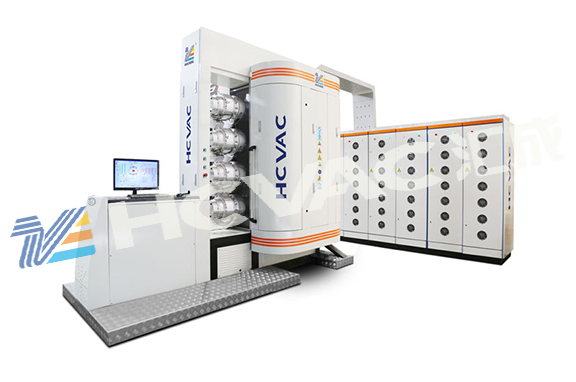The PVD of the pvd coating machine is the abbreviation of "Physical Vapor Deposition" in English, which means physical vapor deposition. Generally, vacuum evaporation coating technology, ion coating technology, and magnetron coating technology are collectively called physical vapor deposition. The most widely used pvd coating machine technologies in daily use mainly include multi-arc plating and magnetron sputtering plating. The multi-arc ion vacuum coating equipment has a simple structure and is easy to operate. Its ion evaporation source can work by being powered by the power supply of the electric welding machine. The arc ignition process is also similar to that of electric welding. Specifically, under a certain process pressure, the arc ignition needle briefly contacts the evaporation ion source and disconnects, causing the gas to discharge. . Since the cause of multi-arc plating is mainly to continuously form a molten pool on the surface of the evaporation source with the help of constantly moving arc spots, the metal is evaporated and deposited on the substrate to obtain a thin film layer. Compared with magnetron sputtering, it It not only has high target utilization rate, but also has the advantages of high metal ion ionization rate and strong bonding force between the film and the substrate. In addition, the color of multi-arc plating coatings is relatively stable, especially when making TiN coatings. It is easy to obtain the same stable golden yellow color in each batch, which is beyond the reach of magnetron sputtering. The disadvantage of multi-arc plating is that under the condition of using traditional DC power supply for low-temperature coating, when the coating thickness reaches 0.3μm, the deposition rate is close to the reflectivity, and film formation becomes very difficult. Moreover, the surface of the film begins to become hazy. Another shortcoming of multi-arc plating is that since the metal evaporates after being melted, the deposited particles are larger, the density is low, and the wear resistance is worse than that of the magnetron sputtering method.

It can be seen that multi-arc coating and magnetron sputtering coating have their own advantages and disadvantages. In order to maximize their respective advantages and achieve complementarity, a coating machine that combines multi-arc technology and magnetron technology has emerged. . In terms of technology, there is a new method of multi-arc plating for priming, then using magnetron sputtering to thicken the coating, and finally using multi-arc plating to achieve the final stable surface coating color.
Around the mid-to-late 1980s, hot cathode electron gun evaporation ion plating and hot cathode arc magnetron plasma coating machines appeared. The application effects were very good, and TiN-coated tools were quickly widely used. Among them, hot cathode electron gun evaporation ion plating uses a copper crucible to heat and melt the metal material to be plated, uses a tantalum filament to heat and degas the workpiece, and uses an electron gun to enhance the ionization rate. Not only can a TiN coating with a thickness of 3~5 μm be obtained, but its combination It has good strength and wear resistance, and it is difficult to remove even by grinding. But these devices are only suitable for TiN coatings, or pure metal films. For multi-element coatings or composite coatings, they are unable to meet the requirements of high-speed cutting of high-hardness materials and diverse mold applications.
At present, the pvd coating machine is based on the traditional magnetron sputtering principle, using an unbalanced magnetic field to replace the original balanced magnetic field, a 50KHz intermediate frequency power supply to replace the original DC power supply, a pulse power supply to replace the previous DC bias, and using auxiliary anode technology, etc. The magnetron sputtering technology has gradually matured and has been applied in large quantities on tool mold coatings. The coatings that have been stably produced now mainly include TiAlN, AlTiN, TiB2, DLC, and CrN. They are also used in Guangdong, Jiangsu, Guizhou, Zhuzhou and other places in my country. This kind of equipment has been introduced one after another, and it has the potential to start a prairie fire.



